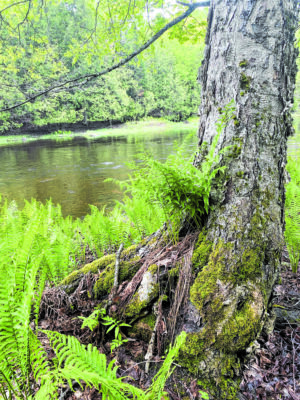If you explore the produce section of your local grocery store in mid-May to early June, you might encounter a strange seasonal vegetable. Intensely green, these spirals resemble the top of a violin; hence their colloquial name “fiddleheads.” This wild-harvested treat usually comes from Maine and Canada and is only available for a very short season.

under the right conditions.
(Photo by Amanda Olsen)
What are fiddleheads?
There are many species of fern that have traditionally been called “fiddleheads.” This includes the bracken fern, which is carcinogenic. For people in the north and east of North America, “fiddleheads” are the unfurled fronds of the ostrich fern, and people have been eating them for centuries. They are traditionally harvested in Northeastern Canada and Northern New England by hand.
The Maliseet and the Mi’kmaq tribes of Eastern Canada and Maine were the first people to harvest and eat the young shoots. This practice was then adopted by the Acadian colonials who were in contact with the Native peoples. In the Passamaquoddy and Maliseet languages, the word for fiddlehead is “mahsus”; in Penobscot, they are “máhsosi.” The double-curve motif that Wabanaki people sometimes use to decorate artwork bears a strong resemblance to a fiddlehead.
According to the Canadian Encyclopedia, Fiddleheads are the only native Canadian plant to achieve commercial success as a vegetable.
Where do fiddleheads come from?
These beautiful green curls begin poking through the wet soil near rivers, streams, and marshes in late April, and are harvested through late May depending on the weather. Fiddleheads can spread through spores, but they mostly reproduce through rhizomes, or spreading roots. A bunch, called a crown, will emerge from the soil and produce up to eight fronds. The bunches are small, tight, and covered in a brown, papery skin. Fiddleheads spread quickly and can cover acres under the right conditions.
How are fiddleheads prepared?
Getting fiddleheads ready to eat is no small task. Once picked, they have to be carefully trimmed and cleaned in cold water to remove all the rusty “paper.” This can take several tries until the water rinses clear. Then they must be blanched and frozen, or if you can’t wait, boiled and eaten with butter and salt. A cold salad of boiled fiddleheads and vinaigrette is also tasty. They are wonderful steamed and then sautéed with garlic. Just remember, whatever recipe you chose, your fiddleheads must be thoroughly cooked. Undercooked fiddleheads can lead to tummy trouble.
Fiddleheads are super good for you.
Fiddleheads are actually a superfood. They have twice the omega-3 fatty acids of blueberries, and are rich in vitamins A and C, iron, and phosphorus.
What do fiddleheads taste like?
These delicious ferns have a taste all their own, but it is sometimes described
as a combination of green beans, asparagus, and spinach. To many people, it tastes like spring.
These wonderful ferns have been steadily gaining notoriety. There are now multiple festivals across the north that celebrate fiddleheads. While fiddleheads are a wild edible, if you are lucky, you might see a basket of them in your local grocery store. They are also available through mail order. The season is short, so be sure to snap them up if you see them.


















